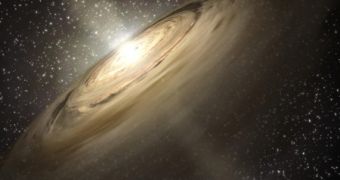It's becoming rather clear now that our solar system is not quite as unique in the universe as previously believed. Only 12 years ago we didn't even know if other planets, except those in our solar system, exist in the universe or not, now there are more than 270 other planets that we know about. Extra-terrestrial life seems to follow the same general trend. Organic molecules can be found throughout the whole solar system, around other stars and most likely inside all galaxies in the universe. We can only calculate the probability that Earth is unique in the universe, but the odds clearly suggest this is hardly the case.
One of the latest discovered such solar systems, containing disks of matter around the star and organic molecules nonetheless, is located only 450 light years away in the Taurus constellation. The AA Tauri system contains a star less than one million years old. "Until now, it has only been possible to see gas very near the star or very far from it," says astronomer Dan Watson from the University of Rochester, part of the investigation team operating NASA's Spitzer Infrared Space Telescope. However, with the help of new instruments and innovative detection techniques, we are now able to observe minute variations in the infrared spectrum, which can put in evidence the presence of simple organic molecules, essential for the apparition and evolution of life.
AA Tauri contains relatively large quantities of some of the basic organic molecules and seem to be concentrated in the habitable zone around the planet, not too close nor too far away. Naval Research Laboratory astronomers John Carr and Joan Najita from the National Optical Astronomy Observatory revealed, with the help of Spitzer's observations, that the disk of matter surrounding the AA Tauri star contains water vapors, hydrogen cyanide, carbon monoxide and some concentrations of carbon dioxide, all of these being essential for the development and evolution of life on our planet.
Habitable zone
Most of these substances have already been detected in some other solar systems and interstellar clouds of gas, however the disk of matter around AA Tauri seems to be right in the habitable zone of the planet, evidence that they were formed there, not collected from interstellar gas. Although, if we were to compare the distance between the Earth and the Sun with that of the location of the disk of matter around AA Tauri, we would find that the distance is nearly three times larger than an astronomical unit, they are still close enough to the star to interact and determine the creation of even complex molecules, and why not, maybe even life.
Spitzer's new observations enabled the team to precisely measure how organic molecules are formed and destroyed inside the disk of matter around AA Tauri. "These clues may ultimately help us answer questions such as whether the chemical precursors for life are commonly created in the planet-forming disks," said Najita.
On top of that, the study brings new insight into understanding the conditions which lead to the formation of rocky planets such as Earth, or Jupiter-like gas giants. Zoltan Balog from the Steward Observatory, says that the new study represents a new advance into understanding the models of proto-planetary disks and their ability to create organic molecules precursors to life.

 14 DAY TRIAL //
14 DAY TRIAL //